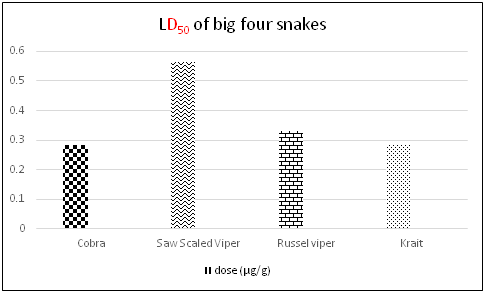International Journal of
eISSN: 2573-2889


Mini Review Volume 3 Issue 2
1Biological Production Division, National Institute of Health, Pakistan
2Veterinary & Farm Management Sub-Division, Pakistan
Correspondence: Ghazala Parveen, Biological Production Division, National Institute of Health, Pakistan, Tel +92 925521
Received: March 30, 2018 | Published: April 24, 2018
Citation: Parveen G, Ali H, Hassan HSU. Lethal dose (LD50) of the big four snakes-a mini review. Int J Mol Biol Open Access. 2018;3(2):78-79. DOI: 10.15406/ijmboa.2018.03.00055
Snake envenoming is a common medical emergency throughout the world. According to WHO estimates of 2017 approximately 5.4 million people receive snake bites every year with up to 2.7 million cases of envenoming, and about 81, 000 to 138, 000 deaths occur due to these bites. Snake bite incidence is most common in Asia and Africa with an incidence of about 2 million and 580,000 annual victims respectively (WHO, 2017). The four most common venomous snakes that cause the highest number of deaths in the South Asian countries collectively called as ‘big four’ are the cobra (Najanaja), Common krait (Bungaruscaeruleus), Russell's viper (Viperarusselii), Saw-scaled viper (Echiscarinatus). The big four accounts for 40,000 bites and almost 8000 annual deaths in Pakistan,1 about 50,000 annual deaths in India,2 1000 annual deaths in Nepal3 and 33,000 bites in Sri Lanka annually.4The only available cure to snake envenoming is the anti-snake venom serum (ASVS) that is acquired by hyperimmunization of animals. Raising antisera is a long and laborious task. So correct determination of LD50 becomes need of hour for efficient production of ASVS.
Several studies have been devised to study the LD50 of big four snakes. The toxicity and lethality of the snake venom varies from species to species and even within the species depending upon geographical location, route of venom injection, age, size, locality, health, body temperature and even mood of the snake. Parveen et al.5 determined the LD50 of big four snakes as LD50 of cobra (NajaNaja) about 6 to 7 μg/dose, Saw Scaled Viper (Echiscarinatus) 11 to 12 μg/dose, Russelviper (Viperarusselli) 5 to 6 μg/dose and Krait (Bungarescaeruleus) 4 to 5 μg/dose when injected intravenously (Figure 1).

Different researcher conducted studies to investigate the LD50 of big four snakes at various institutes. And it is found to be varying in different geographical locations. This study presents the overview of the LD50as estimated by various researchers on mice. The LD50 of Echiscarinatus (Saw-scaled viper) estimated by Parveen et al.5 was 0.5655μg/g and by6was 22 μg/mouse of mice through intravenous route. LD50 of Echiscarinatus multisquamatus which is found in Iran was calculated as 11.1 μg/mouse.7According to Australian online biodata of snake venom LD50 of Echiscarinatus multisquamatus is 3.26 μg/g.8In case of Russell viper (Viperarusselii) the LD50 was 0.3321 μg/g estimated by Parveen et al.5 and 0.3 μg/g as calculated by Meier and Theakston (1986).
Forkrait (Bungaruscaeruleus) LD50 calculated by Perveen et al.5 is 0.2828 μg/g for intravenous route. Engelmann and Obst et al.9 obtained LD50 value is 0.169μg/g and Mirajkar & More et al.10 reported LD50 of 0.16 μg/g. Australian Venom and Toxin database depicts the LD50 value 0.169μg/g for Krait.8 The LD50 of cobra (Najanaja) estimated by Perveen et al.5 was 0.2828 μg/g. Riaz & Zaman11 estimated LD50 of cobra about 1.2μg/g. The lethality of snake venom varies from species to species and even among the individuals of the same species. This is because of multiple factors such as ecological variables, biophysical environment, physical and physiological status, genetic variation (either adaptive or incidental) and various other molecular and ecological evolutionary factors. The influence of such factors in the controlled laboratory settings is although minimal but it cannot be completely eliminated. However, to minimize the variability comprehensive studies covering a range of factors needs to be conducted to determine snake venom lethality or potency.
None.
The author declares no conflict of interest.

©2018 Parveen, et al. This is an open access article distributed under the terms of the, which permits unrestricted use, distribution, and build upon your work non-commercially.